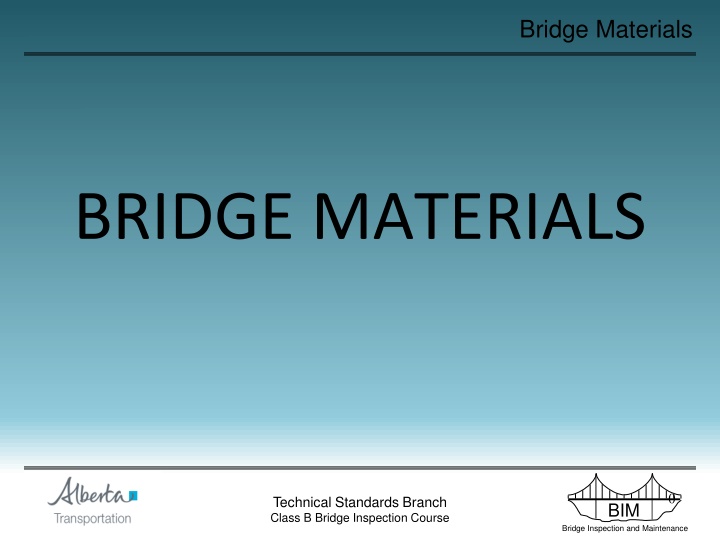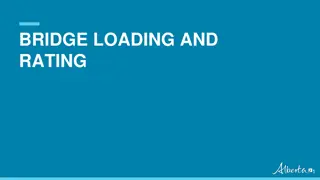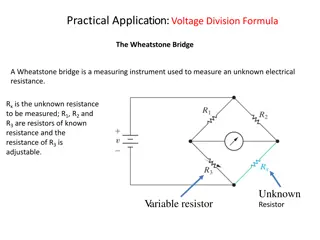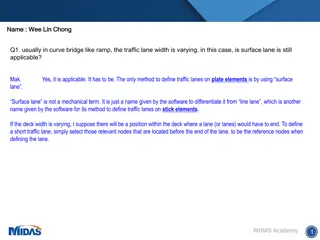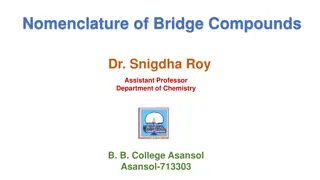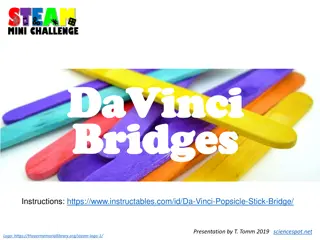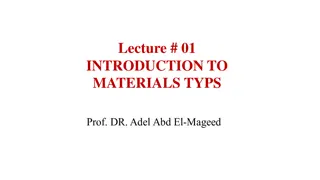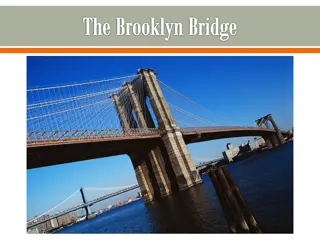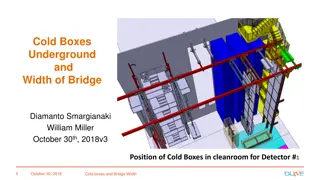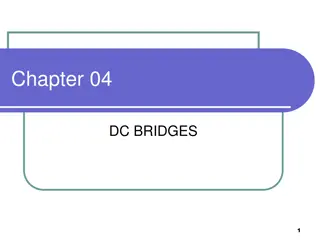BRIDGE MATERIALS
In this comprehensive guide, explore various bridge materials including concrete, cement manufacturing, aggregate, water, entrained air, and air-entrained concrete. Learn about their properties, composition ratios, manufacturing processes, and qualities for strong and durable construction. Discover the importance of technical standards, inspection, and maintenance practices in bridge construction. Gain insights into the role of materials like cement, aggregate, and water in forming a strong and resilient structure. Dive into the world of bridge engineering with a focus on material science and quality assurance.
Uploaded on Feb 22, 2025 | 1 Views
Download Presentation

Please find below an Image/Link to download the presentation.
The content on the website is provided AS IS for your information and personal use only. It may not be sold, licensed, or shared on other websites without obtaining consent from the author.If you encounter any issues during the download, it is possible that the publisher has removed the file from their server.
You are allowed to download the files provided on this website for personal or commercial use, subject to the condition that they are used lawfully. All files are the property of their respective owners.
The content on the website is provided AS IS for your information and personal use only. It may not be sold, licensed, or shared on other websites without obtaining consent from the author.
E N D
Presentation Transcript
Bridge Materials BRIDGE MATERIALS 0 Technical Standards Branch Class B Bridge Inspection Course BIM Bridge Inspection and Maintenance
Bridge Materials CONCRETE 1 Technical Standards Branch Class B Bridge Inspection Course BIM Bridge Inspection and Maintenance
Bridge Materials What is Concrete? A mixture of various components which chemically react to form a strong construction material Unit Weight normal 2400 kg/m3 or semi 1900 kg/m3 Component Ratios: Cement (10 to 15%) Aggregate (75 to 80%) Water and Air (remainder) Admixtures 2 Technical Standards Branch Class B Bridge Inspection Course BIM Bridge Inspection and Maintenance
Bridge Materials Cement Manufacturing Limestone Train Clay Quarry Hammermill Crusher Additive Silos Preheater Tower Preblend Dome Clinker Finishing Mill Roller Mill Gypsum Rotary Kiln Cement Silos 3 Technical Standards Branch Class B Bridge Inspection Course BIM Bridge Inspection and Maintenance
Bridge Materials Aggregate Aggregate qualities for strong and durable concrete: Abrasion resistance Weather resistance Chemical stability Cleanliness and even gradation 4 Technical Standards Branch Class B Bridge Inspection Course BIM Bridge Inspection and Maintenance
Bridge Materials Water 5 Technical Standards Branch Class B Bridge Inspection Course BIM Bridge Inspection and Maintenance
Bridge Materials Entrained Air Entrained air 5% to 8% Improves freeze thaw resistance Improves workability Reduces segregation and bleeding Improves sulfate resistance 6 Technical Standards Branch Class B Bridge Inspection Course BIM Bridge Inspection and Maintenance
Bridge Materials Air-Entrained Concrete 7 Technical Standards Branch Class B Bridge Inspection Course BIM Bridge Inspection and Maintenance
Bridge Materials Admixtures Ingredients used to modify certain properties of concrete to have a desired function Two types of admixtures: Mineral admixtures Chemical admixtures 8 Technical Standards Branch Class B Bridge Inspection Course BIM Bridge Inspection and Maintenance
Bridge Materials Mineral Admixtures Fly Ash Reduces heat of hydration & increases workability Increases set time & reduces strength Silica Fume Increase strength & abrasion resistance Increases water demand Reduces permeability & workability 9 Technical Standards Branch Class B Bridge Inspection Course BIM Bridge Inspection and Maintenance
Bridge Materials Chemical Admixtures Water Reducers reduces water demand Super Plasticisers increases slump, workability, strength Accelerators decreases set time Retarders increases set time 10 Technical Standards Branch Class B Bridge Inspection Course BIM 10 Bridge Inspection and Maintenance
Bridge Materials Physical Properties Compressive strength (f c) Tensile strength Shear strength Flexural strength (28 day) (10% f c) (12-13% f c) (14% f c) 11 Technical Standards Branch Class B Bridge Inspection Course BIM Bridge Inspection and Maintenance
Bridge Materials Physical Properties (Cont d) How to increase Compressive Strength Increased cement content Increased aggregate strength Decreased w/c ratio Decreased entrapped air Increased curing time Use of admixtures 12 Technical Standards Branch Class B Bridge Inspection Course BIM Bridge Inspection and Maintenance
Bridge Materials Concrete Stress-Strain Diagram stress strain 13 Technical Standards Branch Class B Bridge Inspection Course BIM Bridge Inspection and Maintenance
Bridge Materials Physical Properties (Cont d) Creep Fire resistance Durability Isotropy Permeability Affected by evaporation of bleed water excess water micro-cracking porous aggregates improper mixing, finishing 14 Technical Standards Branch Class B Bridge Inspection Course BIM Bridge Inspection and Maintenance
Bridge Materials Concrete Damage & Deterioration 1. CRACKS Crack is a linear fracture in concrete Working Cracks Structural Cracks Flexure cracks Shear cracks 15 Technical Standards Branch Class B Bridge Inspection Course BIM Bridge Inspection and Maintenance
Bridge Materials Structural Cracks Unloaded Beam Flexural Cracks Flexural Cracks Shear Cracks 16 Technical Standards Branch Class B Bridge Inspection Course BIM Bridge Inspection and Maintenance
Bridge Materials Concrete Damage & Deterioration Non-Structural Cracks Crazing cracks Temperature cracks Shrinkage cracks Crack Size Hairline Narrow Medium Wide less than 0.1 mm 0.1 mm < 0.3 mm 0.3 mm < 1.0 mm 1.0 mm 17 Technical Standards Branch Class B Bridge Inspection Course BIM Bridge Inspection and Maintenance
Bridge Materials Shrinkage Cracks on Deck Underside. 18 Technical Standards Branch Class B Bridge Inspection Course BIM Bridge Inspection and Maintenance
Bridge Materials Concrete Damage & Deterioration 2. SCALING Scaling is a gradual loss of mortar and aggregate Categories of Scaling Light scaling loss of surface mortar 6 mm deep Medium Scaling loss of surface mortar 6 to 13 mm deep Heavy scaling coarse aggregate exposed Severe scaling loss of coarse aggregate 19 Technical Standards Branch Class B Bridge Inspection Course BIM Bridge Inspection and Maintenance
Bridge Materials Light Scaling 20 Technical Standards Branch Class B Bridge Inspection Course BIM Bridge Inspection and Maintenance
Bridge Materials Medium Scaling 21 Technical Standards Branch Class B Bridge Inspection Course BIM Bridge Inspection and Maintenance
Bridge Materials Heavy Scaling 22 Technical Standards Branch Class B Bridge Inspection Course BIM Bridge Inspection and Maintenance
Bridge Materials Freeze/Thaw Deterioration of Deck 23 Technical Standards Branch Class B Bridge Inspection Course BIM Bridge Inspection and Maintenance
Bridge Materials Concrete Damage & Deterioration 3. POP-OUTS Due to porous aggregate 4. ABRASION Due to wheel wear 5. SPALLING Expansion of corroding rebar and overstressing 24 Technical Standards Branch Class B Bridge Inspection Course BIM Bridge Inspection and Maintenance
Bridge Materials Expansive Aggregate Pop-out 25 Technical Standards Branch Class B Bridge Inspection Course BIM Bridge Inspection and Maintenance
Bridge Materials Abrasion Damaged Girders 26 Technical Standards Branch Class B Bridge Inspection Course BIM Bridge Inspection and Maintenance
Bridge Materials Concrete Damage & Deterioration 6. DELAMINATION Bond failure between old and new concrete and expansion of corroding rebar 7. STAINING Rust stains leaching through cracks 8. ALKALAI AGGREGATE REACTION 9. CARBONATION (EFFLORESCENCE) 27 Technical Standards Branch Class B Bridge Inspection Course BIM Bridge Inspection and Maintenance
Bridge Materials Delamination Mechanism Top of concrete Wearing surface Reinforcement Corrosion by-products 28 Technical Standards Branch Class B Bridge Inspection Course BIM Bridge Inspection and Maintenance
Bridge Materials Delamination & Corroded Rebar 29 Technical Standards Branch Class B Bridge Inspection Course BIM Bridge Inspection and Maintenance
Bridge Materials Longitudinal Crack & Corroding Rebar 30 Technical Standards Branch Class B Bridge Inspection Course BIM Bridge Inspection and Maintenance
Bridge Materials Corrosion Spall 350 31 Technical Standards Branch Class B Bridge Inspection Course BIM Bridge Inspection and Maintenance
Bridge Materials Calcium Carbonate Deposits 32 Technical Standards Branch Class B Bridge Inspection Course BIM Bridge Inspection and Maintenance
Bridge Materials Concrete - Steel Combination Reinforced Concrete Concrete has high compressive strength and low tensile strength Always cracks under tensile load Mild steel carries tensile load Prestressed Concrete High strength steel strands Concrete is pre-compressed Carries load without cracking 33 Technical Standards Branch Class B Bridge Inspection Course BIM Bridge Inspection and Maintenance
Bridge Materials STEEL 34 Technical Standards Branch Class B Bridge Inspection Course BIM Bridge Inspection and Maintenance
Bridge Materials What is Steel? Steel is an alloy of iron, carbon and other trace metals Carbon and trace metal ratios: Carbon 0.15 to 0.3% Manganese 0.50 to 2.0% Phosphorus 0.02 to 0.2% Sulphur 0.02 to 0.06% Silicon 0.15 to 0.8% 35 Technical Standards Branch Class B Bridge Inspection Course BIM Bridge Inspection and Maintenance
Bridge Materials Iron Iron in the pure form is a soft, shiny metal like aluminum. However, it is never found in this state. Iron oxidizes extremely easily. In nature it is always found as an oxide. 36 Technical Standards Branch Class B Bridge Inspection Course BIM Bridge Inspection and Maintenance
Bridge Materials Steel Making Process Iron ore, coke and limestone are major raw materials. Raw material is charged into Blast furnace which has a temperature of 1600 C. Iron melts and settles at the bottom. Solidified iron is called Pig Iron 37 Technical Standards Branch Class B Bridge Inspection Course BIM Bridge Inspection and Maintenance
Bridge Materials Steel Making Process Molten metal from blast furnace and silicon is taken into Basic Oxygen furnace Chemical analysis of the molten material is done Steel billets are heated to 1200 C for rolling and finished products. 38 Technical Standards Branch Class B Bridge Inspection Course BIM Bridge Inspection and Maintenance
Bridge Materials Bridge Materials 39 Technical Standards Branch Class B Bridge Inspection Course BIM Bridge Inspection and Maintenance
Bridge Materials Bridge Materials Molten Iron 40 Technical Standards Branch Class B Bridge Inspection Course BIM Bridge Inspection and Maintenance
Bridge Materials Effects of Various Elements Effects of Carbon in steel: Increases strength and hardness Reduces ductility, weldability, machinability and toughness Effects of Phosphorus in steel: Increases strength and hardenability Reduces ductility and weldability 41 Technical Standards Branch Class B Bridge Inspection Course BIM Bridge Inspection and Maintenance
Bridge Materials Effects of Various Elements Effects of Manganese in steel: Increases strength, hardenability and notch toughness Reduces weldability Reduces ill effects of sulfur Effects of Sulfur in steel: May cause porosity and hot cracking in welding Can cause brittleness 42 Technical Standards Branch Class B Bridge Inspection Course BIM Bridge Inspection and Maintenance
Bridge Materials Effects of Various Elements Silicon in steel: Increases strength, hardenability and notch toughness Reduces weldability Deoxidizer in steel making Copper, Chrome, Nickel: - Weathering steel (Cor-ten) 43 Technical Standards Branch Class B Bridge Inspection Course BIM Bridge Inspection and Maintenance
Bridge Materials Common Steel Shapes Wires Cables Steel Plates Steel Bars Rolled Beams Built-up Shapes 44 Technical Standards Branch Class B Bridge Inspection Course BIM Bridge Inspection and Maintenance
Bridge Materials Rolled Sections Angle Channel Rolled I Beam 45 Technical Standards Branch Class B Bridge Inspection Course BIM Bridge Inspection and Maintenance
Bridge Materials Built-up Sections 46 Technical Standards Branch Class B Bridge Inspection Course BIM Bridge Inspection and Maintenance
Bridge Materials Bridge Materials Important Physical Properties Strength Compression Tension Fatigue Ductility Notch toughness Weldability Fire Resistant Corrosion Resistant 47 Technical Standards Branch Class B Bridge Inspection Course BIM Bridge Inspection and Maintenance
Bridge Materials Tension & Compression Stress Strain Diagram (+) tension lengthen (+) shorten (-) compression (-) 48 Technical Standards Branch Class B Bridge Inspection Course BIM Bridge Inspection and Maintenance
Bridge Materials Steel Damage and Deterioration Corrosion Environmental corrosion Stray current corrosion Stress corrosion Cracking Fatigue Impact Excessive loading Note: Any crack in a steel member is serious 49 Technical Standards Branch Class B Bridge Inspection Course BIM Bridge Inspection and Maintenance
